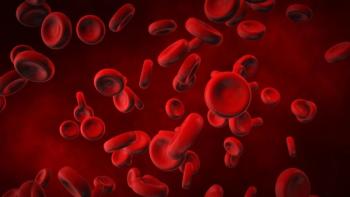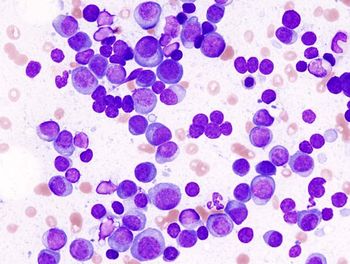
Vincristine/Irinotecan Plus Temozolomide Shows Improved Efficacy in Relapsed/Refractory Rhabdomyosarcoma
The addition of temozolomide to vincristine and irinotecan appears to be a new standard of care for adult and pediatric patients with relapsed/refractory rhabdomyosarcoma, according to the European Paediatric Soft Tissue Sarcoma Group.
Chemotherapy efficacy was improved with the addition of temozolomide (Temodar) to vincristine (Marqibo) and irinotecan (Onivyde; VIT) compared with VI alone for patients with relapsed/refractory rhabdomyosarcoma and may be a new standard of care, according to results from a phase 2 study (NCT01355445) published in the Journal of Clinical Oncology.
The objective response rate (ORR) following 2 cycles of treatment with VIT was 44% (n = 24) and 31% (n = 18) in the VI arm (n = 18; adjusted OR, 0.50; 95% CI, 0.22-1.12; P =.09). The VIT arm also experienced better overall survival (OS) compared with VI (adjusted HR, 0.55; 95% CI, 0.35-0.84; P = .006. Treatment with VIT was also associated with a reduction in risk of progression of relapse that was almost statistically significant (adjusted HR, 0.68; 95% CI, 0.46-1.01; P= .059). In terms of progression-free survival, investigators identified benefit with VIT vs VI (adjusted HRPFS, 0.64; 95% CI, 0.42-0.98; P = .039), as well as a stable and significant OS (adjusted HROS, 0.59; 95% CI, 0.37-0.93; P = .02). Additionally, onvestigators observed more objective responses in the VIT arm (57%; n = 33) compared with the VI arm (38%; n = 22; adjusted OR, 0.40; 95% CI, 0.18-0.88; 2-sided P = .023).
“The [European pediatric Soft Tissue Sarcoma Group] has recently launched its new multiarm, multistage frontline and relapse [relapsed or refractory rhabdomyosarcoma] study, and VIT will be the new standard control arm in relapsed patients. Depending on expected combination toxicity, experimental arms will include VI or VIT backbone, combined with innovative agents,” investigators of the study included.
This phase 2 study enrolled 120 patients who were randomized to either the VI arm (n = 60) or the VIT arm (n = 60). Patients were treated with vincristine at a dose of 1.5 mg/m2 daily on days 1 and 8, as well as 50 mg/m2 of irinotecan once daily on days 1 through 5. Additionally, those in the VIT arm received temozolomide at 125 mg/m2 once daily on days 1 through 5 and 150 mg/m2 daily from cycle 2. Patients were treated in 21-day cycles until disease progression or unacceptable toxicity.
Investigators initially planned to use a Simon 2-stage trial design to separately analyze 40 patients. Following the expansion of the sample size to 120, a comparison between arms and adjustment for confounding factors were added to the statistical plan.
Patients had a median age of 11 years (range, 0.75-45) and 89% of the population had relapsed disease upon enrolling.
The primary end point of the study was ORR after 2 cycles, with key secondary end points including best response, PFS, OS, and adverse effects.
The median follow-up was 57 months. Investigators reported that 104 patients experienced disease progression or relapsed and 91 patients died.
A total of 55 patients experienced progressive disease and needed to discontinued treatment early, and 13 discontinued due to toxicity. Investigators identified a nonsignificant trend in fewer early terminations due to progression and more because of toxicity in the VIT arm (P = .30). Additionally, 16 patients received 12 or more cycles of either VIT or VI.
Additional systemic therapy was administered in 17 patients after they stopped VI or VIT and before progression, including 23% (n = 13) of those in the VIT arm and 7% (n = 4) of those in the VI arm (P =.02). Among those who had local or locoregional disease upon enrolling on the study, 20 patients had local treatment, with 5 having surgery alone, 7 having radiotherapy alone, and 8 having both; no significant differences were noted in the study groups (P = .65).
Grade 3 or higher adverse effects (AEs) occurred in 98% of patients in the VIT arm compared with 78% in the VI arm (P=.009). Additionally, 93% of patients in the VIT arm had AEs related to the study treatment, compared with 69% in the VI arm (P = .002). Additionally, 38% of patients in the VIT arm had a significant excess of serious AEs compared with 19% in the VI arm (P = .023).
Severe hematologic toxicity was reported in 81% of patients in the VIT arm compared with 61% in the VI arm (P = .025). Grade 3 or higher AEs in the VIT and VI arms, respectively, included diarrhea (24% vs 17%; P = .33), as well as nausea or vomiting (26% vs 17%; P = .24). Investigators reported that no study treatment-related deaths occurred.
Reference
Defachelles AS, Bogart E, Casanova M, et al. Randomized phase II trial of vincristine-irinotecan with or without temozolomide, in children and adults with relapsed or refractory rhabdomyosarcoma: a European Paediatric Soft Tissue Sarcoma Study Group and innovative therapies for children with cancer trial. J Clin Oncol. 2021;39(27):2979-2990. doi:10.1200/JCO.21.00124
Newsletter
Stay up to date on recent advances in the multidisciplinary approach to cancer.

















































































